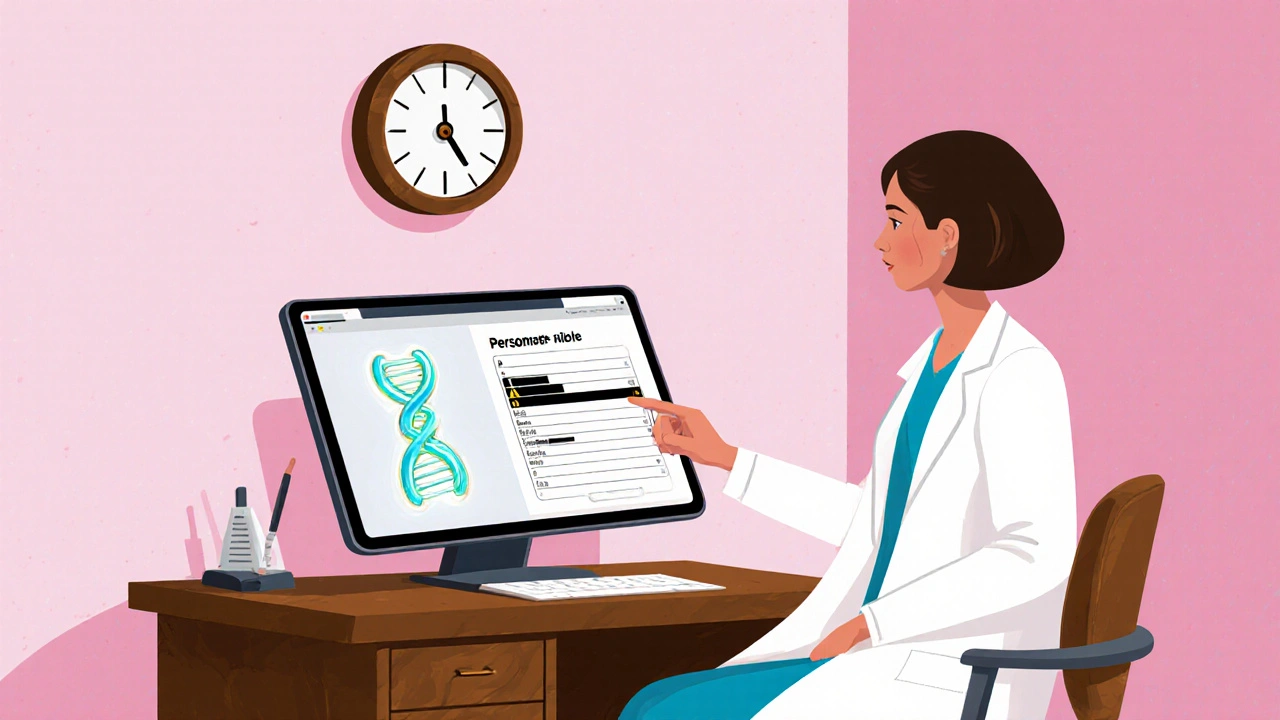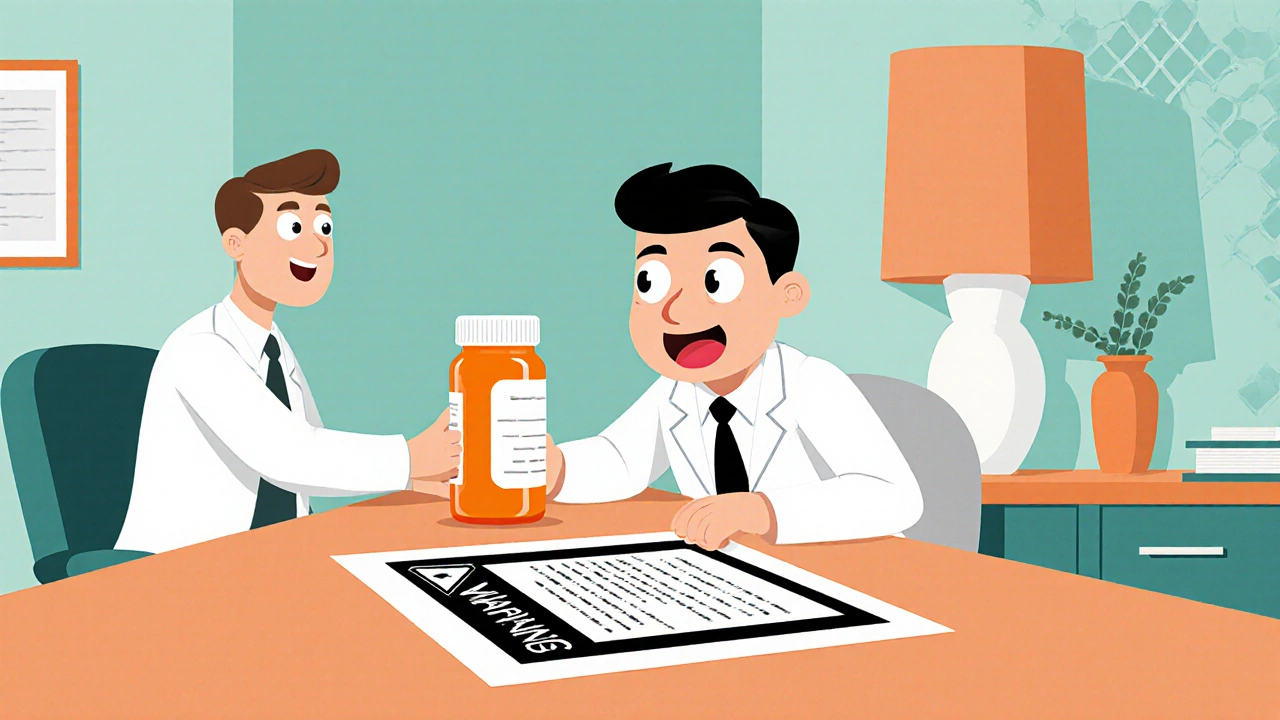Black Box Risk Assessment Tool
This tool helps healthcare providers and patients evaluate the risk-benefit ratio of medications with FDA black box warnings based on individual patient factors.
Risk Assessment Results
Key Takeaways
- Boxed warnings are the FDA’s most serious safety alerts, flagged with a black border on drug labels.
- They are added mainly after post‑marketing data show life‑threatening risks.
- Prescribers must weigh the warning against therapeutic benefits and may need to follow REMS requirements.
- Patients should discuss the specific risks, monitoring plans, and alternatives with their healthcare provider.
- Future warnings will likely incorporate genetic data for more precise risk communication.
Understanding the highest‑level safety alerts on prescription drugs can feel overwhelming. The FDA black box warning is the most serious safety advisory the United States Food and Drug Administration can place on a medication’s label, highlighted by a distinctive black border. This article breaks down what triggers a black box warning, how it’s communicated, and what it means for doctors and patients alike.
What Exactly Is a Black Box (Boxed) Warning?
In everyday language the term “black box warning” is used because the warning text sits inside a bold black frame on the package insert. Legally, the FDA defines it as a boxed warning that must appear near the beginning of the prescribing information, under 21 CFR 201.56 and 201.57. The warning flags risks that could be fatal or cause serious injury, or it may signal that special monitoring, patient‑selection criteria, or prescribing restrictions are required.
The warnings serve two core purposes:
- Alert clinicians to life‑threatening adverse events before they write a prescription.
- Inform patients so they can weigh the benefits against the disclosed hazards.
Because the warning sits at the top of the label, it is hard to miss - a design decision reinforced by the FDA’s 2021 guidance that placed it immediately after the “Highlights of Prescribing Information” section.
How the FDA Decides a Black Box Warning Is Needed
Most boxed warnings are not part of the initial approval package. Instead, they often arise from the FDA’s post‑marketing surveillance system, especially the FAERS (FDA Adverse Event Reporting System). Each year the agency reviews roughly 1.3 million reports, looking for patterns that suggest a serious safety signal.
Three main criteria guide the decision:
- Severity: The risk must be life‑threatening or cause permanent disability.
- Mitigation Potential: The danger can be reduced with specific monitoring, dosage adjustments, or avoidance of drug interactions.
- Population Impact: The risk may outweigh the drug’s benefits for particular groups (e.g., pregnant women, children, patients with certain comorbidities).
When these conditions are met, the FDA drafts the warning text, works with the manufacturer to ensure clarity, and then updates the label. If further evidence shows the risk has lessened, the agency can amend or remove the warning.
Where You’ll See the Warning
Boxed warnings appear in several places:
- Package Insert: The physical document that accompanies every prescription drug.
- Physicians' Desk Reference (PDR): A quick‑reference book used by many clinicians.
- Online Databases: The FDA’s Drugs@FDA portal lists current boxed warnings for every approved medication.
- Company Websites: Manufacturers must display the warning on their drug information pages.
In addition, if a drug carries a Risk Evaluation and Mitigation Strategy (REMS), extra steps such as prescriber certification or patient registries may be required beyond the boxed warning itself.
Impact on Prescribing and Patient Care
Research shows that a new black box warning can dramatically change prescribing patterns. After the FDA added a boxed warning to rosiglitazone (Avandia), prescription rates fell by about 70 %. However, the drug remained in use for patients who had no safer alternatives, underscoring that a warning does not equal a ban.
Clinicians typically follow a decision framework known as STEPS (Safety, Tolerability, Effectiveness, Price, Simplicity). The presence of a boxed warning forces a deeper safety assessment, often prompting:
- More frequent lab monitoring (e.g., liver function tests for certain antiretrovirals).
- Alternative therapy discussions with the patient.
- Documentation of informed consent when the risk is especially high.
Patients receiving a medication with a boxed warning should expect their provider to outline:
- The specific risk(s) being highlighted.
- Any required monitoring (blood tests, imaging, symptom check‑ins).
- Potential alternatives and why they may or may not be appropriate.
- Steps for reporting side effects, usually via the MedWatch program.
Common Misconceptions
One myth is that a black box warning means the drug is unsafe for everyone. In reality, the warning flags a risk that may be manageable with proper precautions or that only affects a subset of patients. Another misconception is that physicians will avoid prescribing the drug altogether. While some clinicians steer clear, many continue to use the medication when the therapeutic benefit outweighs the disclosed risk.
Finally, patients sometimes think reporting an adverse event is optional. The FDA encourages anyone experiencing a serious side effect to file a report; these data are crucial for future safety updates.

Future Trends: Personalizing the Warning
The FDA’s 2023‑2027 strategic plan calls for integrating pharmacogenomic data into labeling. Imagine a boxed warning that says, “Patients with the CYP2D6 *4 allele have a 5‑fold increased risk of severe cardiac arrhythmia.” Such precision would help clinicians decide who truly needs the warning and who can safely use the drug without extra monitoring.
Digital labeling is another emerging area. Instead of a static text box, an electronic health record could pull a patient’s age, kidney function, and genetic profile to display a tailored risk summary at the point of prescribing.
Practical Tips for Providers and Patients
Below is a quick checklist you can use the next time a medication with a black box warning is considered.
| Step | What to Do | Why It Matters |
|---|---|---|
| 1 | Read the full boxed warning text in the prescribing information. | Ensures you understand the specific risk and any required monitoring. |
| 2 | Assess patient‑specific risk factors (age, comorbidities, genetics). | Identifies whether the warning applies to this individual. |
| 3 | Discuss the warning with the patient and obtain informed consent. | Promotes shared decision‑making and legal documentation. |
| 4 | Implement any required REMS components (certification, registries). | Meets regulatory obligations and enhances safety. |
| 5 | Schedule follow‑up labs or clinical visits as stipulated. | Detects adverse events early, allowing timely intervention. |
| 6 | Encourage the patient to report side effects via MedWatch. | Feeds data back to the FDA for ongoing safety monitoring. |
Bottom Line
The FDA black box warning is a vital safety tool, not a death sentence for a drug. It tells clinicians when a medication’s risks are serious enough to demand extra caution, monitoring, or even restricted use. By staying informed about the warning’s specifics, following the checklist, and keeping the dialogue open with patients, you can safely navigate these high‑risk therapies while still delivering the therapeutic benefits they were designed to provide.
What types of risks trigger a black box warning?
Risks that can cause death, permanent disability, or serious organ damage usually trigger a black box warning. Examples include severe cardiac events, life‑threatening infections, and major hemorrhage risks.
Can a boxed warning be removed?
Yes. If new clinical data show the risk has decreased or can be effectively mitigated, the FDA can revise or remove the warning during a label update.
How does a REMS differ from a boxed warning?
A REMS is an additional program that may accompany a boxed warning. It can require prescriber certification, patient enrollment, or special dispensing conditions to ensure safe use.
Where can I find a current list of drugs with black box warnings?
The FDA’s Drugs@FDA database provides a searchable list of all approved medications with active boxed warnings.
Should I stop taking a medication that has a black box warning?
Not necessarily. The decision depends on your individual health situation. Talk to your provider about the specific risk, monitoring needs, and any safer alternatives before making a change.


Write a comment